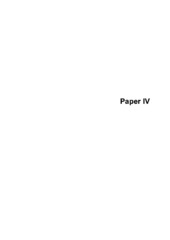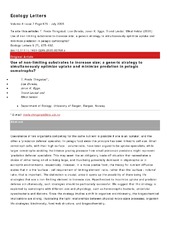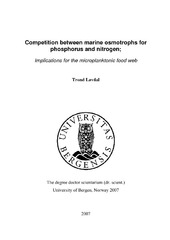| dc.contributor.author | Løvdal, Trond | eng |
| dc.date.accessioned | 2007-05-22T08:35:36Z | |
| dc.date.available | 2007-05-22T08:35:36Z | |
| dc.date.issued | 2007-03-29 | eng |
| dc.identifier.isbn | 978-82-308-0313-4 (print version) | en_US |
| dc.identifier.uri | http://hdl.handle.net/1956/2240 | |
| dc.description.abstract | Understanding how competition for nutrients structures the flows of C, N, P, and other elements through the microbial food web may seem central to our understanding of the role and function of this part of aquatic ecosystems, both in biological and biogeochemical contexts. Competition between phytoplankton and heterotrophic bacteria potentially influences the species composition of the respective communities and the flow of carbon (C) and energy to higher trophic levels. The dominating hypotheses on algal – bacterial competition for inorganic substrates are based on studies from freshwater environments, there is relatively little work on the competition for organic substrates, and previous studies on this topic may seem contradictive. This thesis includes studies performed in nutrient manipulated coastal mesocosms where the algal – bacterial competition for organic and inorganic forms of P and N were assessed. Algal – bacterial competition for these substrates was compared by means of biomass-specific affinity estimates. Biomass-specific affinity is regarded as the best index to measure competitive ability. However, we are not aware of any published papers reporting such data on organic P- and N-compounds. Results from two mesocosm studies, one focusing on P-competition and the other focusing on N-competition, demonstrates a potential for different structuring of the microbial food web in P- versus N-limited environments. One paper considers possible theoretical solutions to the coexistence of organisms competing for the same limiting nutrient. Traditionally, the smallest organisms have been viewed as superior competitors, based on a relatively constant relationship between volume and the intracellular content of the limiting element. However, the paper points out strategies in which organisms can benefit from other resources to change their stoichiometry and thus obtain competitive advantages, as well as predator defense. Experimental evidence to support this theory was obtained from a chemostat experiment. The results demonstrated that Vibrio splendidus could use excess organic C (glucose) to increase in size thereby optimizing uptake of the limiting element (P). | en_US |
| dc.format.extent | 385172 bytes | eng |
| dc.format.extent | 294836 bytes | eng |
| dc.format.extent | 264778 bytes | eng |
| dc.format.extent | 28156 bytes | eng |
| dc.format.extent | 233352 bytes | eng |
| dc.format.mimetype | application/pdf | eng |
| dc.format.mimetype | application/pdf | eng |
| dc.format.mimetype | application/pdf | eng |
| dc.format.mimetype | application/pdf | eng |
| dc.format.mimetype | application/pdf | eng |
| dc.language.iso | eng | eng |
| dc.publisher | The University of Bergen | en_US |
| dc.relation.haspart | Paper I: Løvdal, Trond; Tanaka, Tsuneo and T. Frede Thingstad, Algal – bacterial competition for phosphorus from dissolved DNA, ATP and orthophosphate in a mesocosm experiment. Preprint. To be published in Limnology and Oceanography 52(4), July 2007. Copyright 2007 by the American Society of Limnology and Oceanography, Inc. | en_US |
| dc.relation.haspart | Paper II: Løvdal, Trond; Moros, Christiane; Grossart, Hans-Peter; Carbonnel, Vincent; Chou, Lei and T. Frede Thingstad, Competition for inorganic and organic forms of nitrogen and phosphorus between phytoplankton and bacteria during an Emiliania huxleyi springbloom. Preprint. | en_US |
| dc.relation.haspart | Paper III: Ecology Letters 8, Thingstad, T. Frede; Øvreås, Lise; Egge, Jorun K.; Løvdal, Trond and Mikal Helda, Use of non-limiting substrates to increase size; a generic strategy to simultaneously optimize uptake and minimize predation in pelagic osmotrophs? l., pp. 675-682. Copyright 2005 Blackwell. Fulltext not available in Bora due to publisher restrictions. <a href=”http://dx.doi.org/10.1111/j.1461-0248.2005.00768.x" target=_"blank"> http://dx.doi.org/10.1111/j.1461-0248.2005.00768.x</a> | en_US |
| dc.relation.haspart | Paper IV: Løvdal, Trond; Skjoldal, Evy F.; Heldal, Mikal; Norland, Svein and T. Frede Thingstad, Changes in morphology and elemental composition of Vibrio splendidus along a gradient from carbon-limited to phosphate-limited growth. Submitted to Microbial Ecology, 2006. Published by Springer-Verlag. | en_US |
| dc.title | Competition between marine osmotrophs for phosphorus and nitrogen : implications for the microplanktonic food web | en_US |
| dc.type | Doctoral thesis | |
| dc.subject.nsi | VDP::Matematikk og Naturvitenskap: 400::Zoologiske og botaniske fag: 480::Marinbiologi: 497 | nob |



